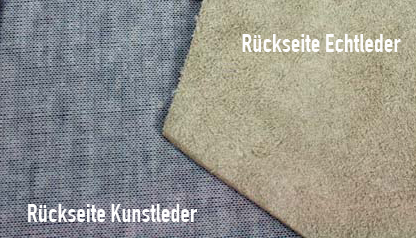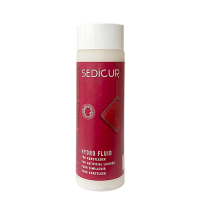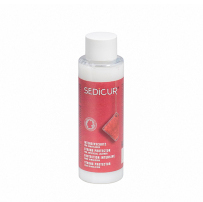What is artificial leather?
Put simply, artificial leather is a synthetic material that looks like real leather but is not. Synthetic leather is an imitation leather and is produced by coating textile carrier fabrics (cloth) with elastic synthetic materials. Polyurethane (PUR) or polyvinyl chloride (PVC) are usually used for this purpose. The material can be produced with a matt or glossy surface. This is then embossed in various structures to imitate a natural leather look.

How can you recognize artificial leather?
The textile back (fabric) is typical of artificial leather. To clearly recognize artificial leather, the material must therefore be turned inside out. Unfortunately, this is not always possible, as you would have to “take apart” a couch or handbag, for example, to get to the underside of the material. Exact information must then be requested from the manufacturer of the article.
It is often claimed that you can recognize genuine leather by its smell. It is true that the typical leather smell cannot be transferred to artificial leather. However, not all genuine leather smells like leather; only very natural types of leather actually have the characteristic smell. The “smell test” is therefore an experiment, but not proof.
How does leather differ from artificial leather?
Genuine leather is tanned animal skin, i.e. a natural material. Imitation leather, on the other hand, is a collective term for textile materials that are coated (usually on one side of the surface) with plastic (usually PVC). A special embossing merely imitates the look of leather.
What are the advantages and disadvantages of faux leather?
Artificial leather: advantages
- The biggest advantage of faux leather over real leather is certainly the low price. Genuine leather is very time-consuming and expensive to produce and the natural characteristics of animal skin often result in a lot of waste. Imitation leather, on the other hand, can be produced very economically.
- Synthetic leather is also very robust and durable and more resistant to sun and water. It is also used in the contract sector (catering, medicine, etc.) where seating furniture gets dirty quickly and has to be cleaned and disinfected frequently.
Artificial leather: disadvantages
- We've all been there: if you sit on an imitation leather chair or car seat in shorts in summer, you'll get “sticky”. As artificial leather has no breathability due to the closed surface, you sweat more quickly and it feels uncomfortable. Another example: you sweat faster in rubber boots than in leather shoes. Genuine leather can “breathe” through the skin pores and thus adapt to the body temperature.
- Another disadvantage is that, unlike real leather, artificial leather cannot be repaired. If you have breaks, cuts or a burn hole, the textile underside shines through and the damaged area remains visible.
How and with what do you clean artificial leather?
The cleaning and care of faux leather furniture differs considerably from that of real leather: Real leather is cleaned and then treated with a slightly moisturizing care lotion. This can penetrate deep into the leather through the skin pores and nourish it from the inside.
Synthetic leather, on the other hand, is cleaned and then moisturized. In contrast to real leather, artificial leather is not refattened, as the plasticizers in the PVC artificial leather coating interact unpleasantly with the fatty and oily substances in a care cream and can damage the surface. In addition, the closed PVC coating cannot absorb the cream, which would simply leave an unsightly film on the surface.
What should not be forgotten with artificial leather after every cleaning is the moisturizing care with SEDICUR® Hydro Fluid. Without this care, artificial leather can also dry out and become brittle over time.
Product recommendations for cleaning and caring for artificial leather:
The ideal care for artificial leather after every cleaning procedure:
- provides precious care
- spends important moisture
- ensures a pleasant, smooth grip
Effective protection against premature soiling, e.g. from jeans staining.
Caring for and protecting artificial leather
We recommend dusting artificial leather furniture weekly with the Cleaning Glove. The glove should be slightly moistened. Regular cleaning with the Cleaning Glove removes everyday dirt as well as light oil and grease stains.
Treat stains and soiling with the special SEDICUR® Cleaner. After cleaning, SEDICUR® Hydro Fluid provides valuable moisture and ensures a soft feel and a smooth, pleasant surface.
Imitation leather furniture is usually exposed to high levels of wear and tear in everyday life. It is therefore advisable to protect the upholstery material from premature soiling and especially from denim discoloration after every cleaning and care.
Thorough cleaning and care is recommended every six months.

